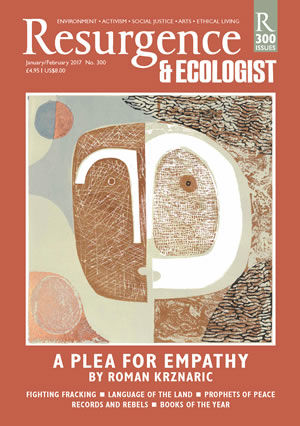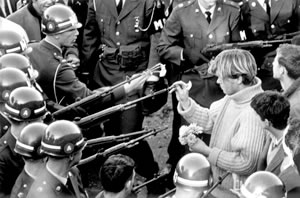Fifty years ago, this magazine was launched; a product of remarkable, turbulent times. Just how remarkable and how turbulent is, at least in part, the concern of You Say You Want a Revolution? Records and Rebels 1966–1970, the latest in a series of exhibitions at London’s Victoria and Albert Museum to focus on pop culture, and by far the widest-ranging.
The title of the exhibition is, of course, taken from the opening lines of the Beatles’ 1968 song Revolution (“You say you want a revolution / Well, you know / We all want to change the world…”), and the show’s curators examine the relationship between the explosion in popular art forms during the period and its wider context and potential significance.
Thus, along with the lovingly assembled and displayed collection of pop ephemera – reminiscent of other V&A exhibitions in recent years that drew crowds to see the costumes of Kylie Minogue or David Bowie – are the curators’ laudable efforts to show the wider perspectives of the era: politics, economics, and the emergence of trends and topics that continue to resonate: the struggles for human, civil and sexual rights in the era of the cold war, apartheid and post-colonialism; the war in Vietnam, the student revolts of 1968; a new interest in various forms of spirituality, particularly those of the East; the development of feminism, environmentalism, consumerism and much more.
It’s a vast canvas, which raises the question of just how important the pop culture – and more importantly the counterculture – of the late sixties really was. Did it really change the world? This exhibition certainly suggests so. I’m not so sure – or that the changes were what the counter-culture intended. Bob Dylan, whose early 1960s protest songs prefigured much of the decade’s debates may now be the Nobel Laureate in Literature, but some of the work considered in You Say You Want a Revolution proved to be more ephemeral.
That said, it is impossible to deny the energy of this exhibition, or the era that it represents. After a brief section referencing the early sixties – short films recall President Kennedy’s pledge that America would put a man on the moon by the decade’s end, British politics and the Profumo affair, Kennedy’s assassination in 1963 – events chronicled largely in monochrome, the events of 1966 and after have a more vivid feel, and the explosion of creativity is undeniable.
The exhibition seeks to reflect the events of the period 1966–70 through a pop prism. Thus there are iconic artefacts aplenty – Mary Quant dresses, some of the Beatles’ costumes from Sgt Pepper’s Lonely Hearts Club Band and handwritten lyrics for some of their most celebrated songs, and so on – but also examples of the wider counterculture, whether psychedelic-informed artwork for album covers and concert posters, or examples of the underground press that grew up to report and comment on the changing times – a press with which Resurgence shared many concerns.
There are strong sections in this exhibition on the struggle for civil rights in the US, with particular emphasis on the emergence of the Black Power movement. The traumatic impact of the Vietnam war on American society, as well as the wider response around the world – with anti-war protests becoming a regular occurrence in western Europe and elsewhere, also has its musical counterpoints.
There are also sections on the growth of a new consumer culture, in which the new sense of individualism engendered in the era was co-opted by mass marketing, and on the rise of new technologies. This magazine’s Undercurrents section has its origins in 1960s enthusiasm for new means of solving social problems through environmentally benign technologies, and it is therefore fascinating to be reminded of some of the alternative architects of our modern world.
There are also inconsistencies aplenty, just as there were back in the day. A small section of the exhibition focuses on the rise of a new wave of feminism and the women’s movement (“Tucked away in a corner, I see,” my female companion commented), but it is noticeable that much of the iconography of the ‘liberated’ sixties counterculture was still remarkably sexually exploitative. It’s possible to suggest that the immensely influential contribution of many African-American musicians in the period is also underrated. And it’s also legitimate to ask just how influential, beyond the centres of London, New York and the US West Coast, much of the late-sixties counterculture really was at the time.
One of the closing themes of the exhibition suggests that much of modern environmentalist concerns have their origin in the period. This is undoubtedly true – though much pioneering work had been done before 1966, of course – and it is interesting to see not only how a section of the counter-culture adopted back-to-the-land ideas of self-sufficiency and a return to Nature, but also how new popular cultures and technologies were able to focus attention on the Earth’s fragility – the photographs of our planet taken by Apollo astronauts in 1968, for example. Even before the celebration of the first Earth Day in April 1970, the New York Times had commented: “Call it conservation, the environment, ecological balance, or what you will, it is a cause more permanent, more far-reaching, than any issue of the era – Vietnam and Black Power included.”
Towards the end of the exhibition, one large gallery offers visitors the chance to recline on giant scatter cushions while watching film clips from the 1969 Woodstock Festival. Seeing pre-dinner exhibition-goers relax as they watched Jimi Hendrix memorably reinterpreting The Star-Spangled Banner – arguably one of the most politically charged, angry and anguished pieces of guitar work of the era – seemed to sum up the contradictions of the sixties themselves. Probably the best compliment to pay to this marvellously rich, occasionally moving and often provoking exhibition is that it similarly prompts many more questions than it answers.
You Say You Want a Revolution? Records and Rebels 1966–1970 continues until 26 February at the Victoria and Albert Museum, London, in partnership with the Levi’s® brand; sound experience by Sennheiser. www.vam.ac.uk/revolution







